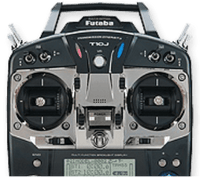New To R/C Flight? It's All About The Stick Inputs
by Todd BredaWhen you are new to the hobby of R/C flight, there are several things you will eventually need to learn to grow in the hobby. Today I am going to focus on one of the most important elements of flying successfully.
Stick Input/Control.
One of the most common things newcomers to flight think is to assume in order to properly control your aircraft (whether it's learning to fly a full scale or R/C model), you must move the stick (or yoke) in wide strokes. This is called over-controlling, and it's quite common at first.
However, you will quickly learn that an aircraft requires very little input to fly effectively in normal flying conditions. Have you ever been on a commercial jet looking out your window and notice the ailerons barely moving? Even in a steep banking turn, the ailerons really aren't moving up or down in wide arcs but mere small degrees of movement.
This same methodology applies to your R/C model.
I like to use the difference between a detailed drawing versus a large canvas painting as an analogy.
Think of the transmitter as your canvas, and the control sticks are your drawing tool. You want to approach the sticks like they are a fine point pencil or pen and you are working on a detailed drawing. The movements of the pencil in your hand under these circumstances are controlled with small movements, slow and easy, yet deliberate.
Conversely, what you do not want to do is approach the sticks like they are a large paint brush and you are painting broad strokes.
This visualization should help guide you initially as you learn how to fly. Smooth flying requires minimal control inputs, in fact you will be surprised by just how small the inputs need to be for your aircraft to fly smoothly.
Here's a quick video that illustrates this concept visually:
I hope this helps you in your journey of becoming a happy and proficient R/C pilot!
Happy Landings!
Get the latest from Motion RC sale and product announcements
You can unsubscribe at any time!

Hobby Squawk Community Forum
visit forum
RC Knowledge Blog
visit blog
Guidance & advice for beginners
Find out more- Choosing a selection results in a full page refresh.
- Press the space key then arrow keys to make a selection.



